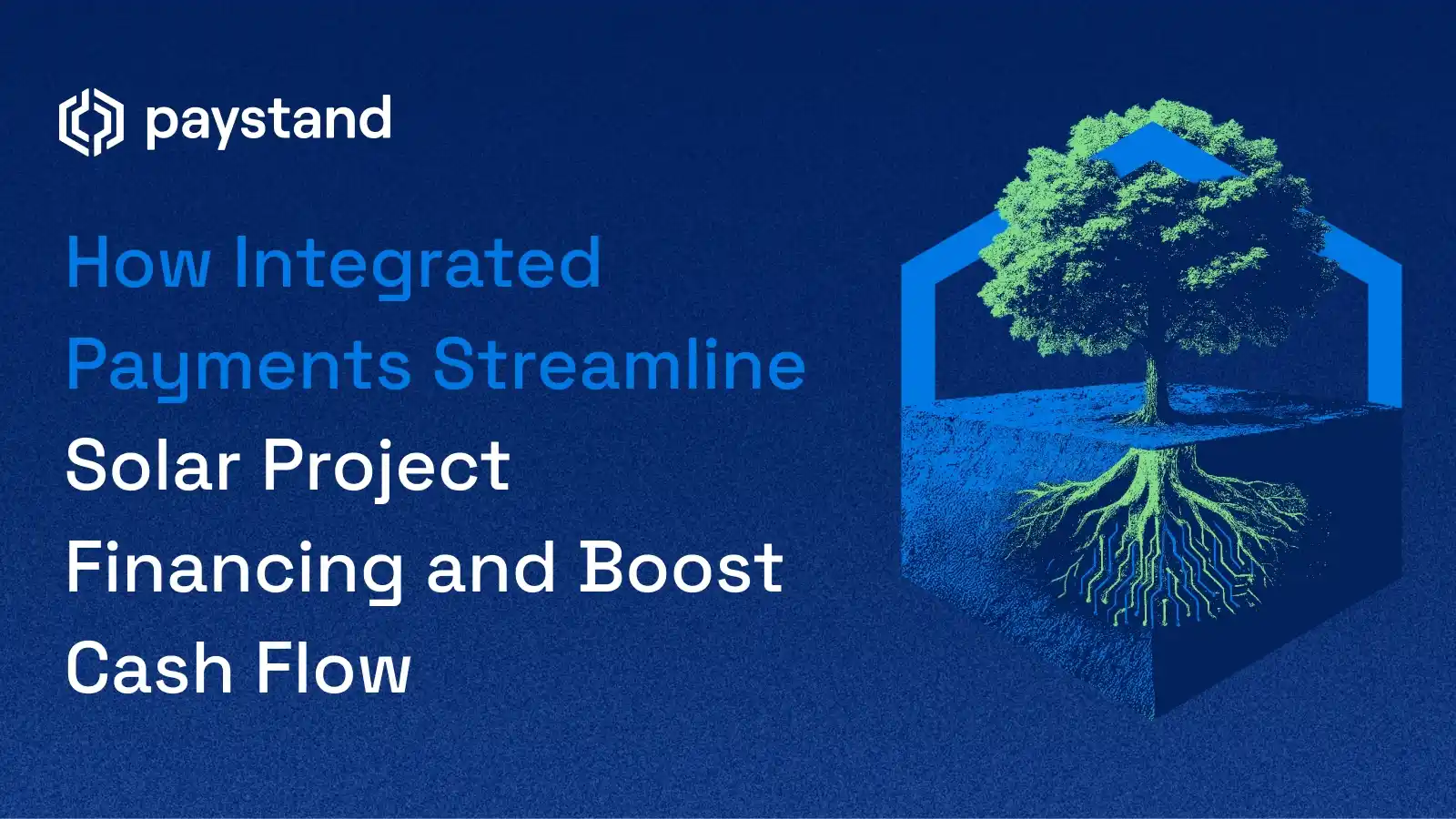Integrated Payments: A Smarter Approach to Solar Project Financing

Table of Contents
- How to Finance a Solar Energy Project: Where to Start
- Solar Financing Options in Renewable Project Finance
- Can I Get a Loan for Solar Panels?
- How to Apply for Solar Financing?
- Who Offers the Best Solar Financing?
- Is Solar Project Financing Available?
- What Are the Steps to Finance Solar?
- How Does Solar Project Financing Work?
- Are There Grants for Solar Projects?
- What Is the Process for Solar Financing?
- Financing the Future of Clean Energy
Key Takeaways:
- Solar project financing is complex—long timelines, layered funding, and delayed payouts. Outdated payment systems only make it worse.
- Integrated payments help solar companies improve cash flow, eliminate unnecessary costs, and streamline collections.
- Paystand enables solar developers and EPC firms to modernize their payment infrastructure with automation, zero-fee rails, and real-time financial insights.
The solar industry is growing fast—but that growth brings financial complexity. Long sales cycles, delayed payouts, and outdated systems can strain cash flow. In this article, we’ll explore key questions around solar project financing—and how integrated payments help streamline operations and improve receivables.
How to Finance a Solar Energy Project: Where to Start
Solar project financing typically involves multiple layers: loans, solar leases, and power purchase agreements (PPAs). Developers often work with banks, investors, or third-party providers to structure funding over 15–25 years. While this supports capital-intensive builds, it also stretches revenue timelines and complicates A/R and payment operations.
Receivables are often delayed for months post-installation, especially in utility-scale or commercial projects. It's common for solar developers to offer payment plans—typically net 30, 60, or even 90 days after installation or milestone achievement. Without the right financial infrastructure, developers end up chasing payments across multiple systems—and watching valuable cash sit idle.
Solar Financing Options in Renewable Project Finance
Common solar financing options include:
- Fixed-rate loans (often backed by federal or state programs)
- Solar leases (customers lease systems rather than purchase)
- PPAs (customers pay only for the electricity generated)
- Equity investments and tax credit monetization
Each option affects billing and cash flow differently. But regardless of the method, developers need fast, predictable payment cycles to stay efficient. That’s where integrated payments shine—bridging the gap between invoicing and actual cash in the bank.
Explore the tech tools supporting this shift in 6 Cloud Software Platforms for the Solar Industry.
Can I Get a Loan for Solar Panels?
Yes. Both residential and commercial solar customers can access solar energy loans through banks, credit unions, and specialized clean energy lenders. For developers and EPCs, though, the question isn’t just can the customer finance the system—it’s how long will it take for us to get paid?
Delays in customer loan disbursement or payment approval can hold up receivables. Without automation, AR teams spend time chasing checks and reconciling spreadsheets instead of improving cash flow. Modern AR systems with integrated payments help solar companies move faster, matching the pace of today’s financing structures.
How to Apply for Solar Financing
While end users apply for solar financing through lenders, developers manage their own financing process with every new project. Coordinating financing structures across multiple stakeholders—banks, investors, utilities—requires clean invoicing, transparency, and speed.
Traditional systems, especially manual invoicing, often cause:
- Payment delays
- Lost or mismatched records
- Limited visibility across stakeholders
Read how adopting eCheck payments and digital workflows helps solar firms cut friction and get paid faster.
Who Offers the Best Solar Financing Options?
There’s no one-size-fits-all answer—because the “best” financing depends on project size, customer type, and developer preferences. But here’s what top solar developers have in common: they pair smart funding strategies with smarter internal payment systems.
It’s not just about the loan or lease terms—it’s about what happens after the deal closes. Developers using integrated payments can reduce transaction fees, automate payment collection, and eliminate delays that erode margin and slow growth.
Learn more about the ROI of integration in Why Payment Gateway Integration Is the Key to AR Automation and Cost Reduction.
Is Solar Project Financing Available?
Absolutely. In fact, solar financing is more available than ever, thanks to government incentives, increased lender participation, and the growing momentum behind clean energy.
The challenge today isn’t access—it’s efficiency. Many developers still rely on outdated AR systems that delay billing, increase risk, and hinder forecasting.
Integrated payments solve this challenge by:
- Eliminating high-fee credit card charges
- Accelerating time-to-cash with automated invoicing
- Consolidating multi-vendor processes into one platform
Take it from Alterra Solar, who cut transaction costs by 51% and increased zero-fee payment volume by 41% after adopting Paystand’s platform.
What Are the Steps to Finance Solar?
For developers, financing a project means managing:
- Investor or lender engagement
- Legal and compliance setup
- Customer agreements (PPA or lease)
- Construction and installation
- Payment collection and ongoing service
Collecting payments is often where things fall apart. Without an integrated system, it’s easy for payments to get delayed, misapplied, or trapped in manual processes.
Paystand helps solar project developers stay ahead with a platform designed to accelerate receivables, reduce processing costs, and improve financial visibility. Learn more in Solutions for Slim Margins in the Solar Industry.
How Does Solar Project Financing Work?
Solar project financing structures allocate the upfront capital needed to design, permit, and install systems while spreading payments over time. These long-term models reduce upfront costs but increase AR complexity for developers.
Because revenue is earned over years (not weeks), solar firms need tools that can scale, automate, and optimize every step of the cash cycle.
With Paystand, companies benefit from:
- Real-time AR insights
- Branded customer payment portals
- Seamless ERP integration
- 0% transaction fees on qualifying payments with Paystand’s B2B Network
It’s a future-proof approach to managing renewable energy project cash flow.
Are There Grants for Solar Projects?
Yes, especially for utility-scale and public-sector installations. State, federal, and nonprofit-backed grants are available, but they often come with added reporting demands.
Integrated AR systems make compliance easier by centralizing records, automating workflows, and ensuring clean audit trails. Instead of cobbling together payment data across platforms, solar teams can stay focused on growth and service.
What Is the Process for Solar Financing?
In the solar world, financing is both an enabler and a constraint. It makes big projects possible—but it also requires speed, structure, and accountability. And that’s where payment infrastructure matters.
Payments shouldn’t be an afterthought. For solar companies, they’re a strategic lever—one that impacts debt service, margin, scalability, and customer experience.
The benefits of solar extend beyond clean energy. With the right financial systems, developers can achieve stronger cash flow, fewer errors, and tighter alignment between revenue and results.
Financing the Future of Clean Energy
The strategic role of integrated payments in solar finance
The solar industry isn’t slowing down, but outdated financial workflows are holding too many developers back. Whether managing PPAs, solar leases, or fixed-rate loans, your AR system is critical in delivering real, measurable ROI.
Modernizing that system with integrated payments helps solar companies:
- Speed up receivables
- Eliminate transaction fees
- Improve working capital across every project
Ready to modernize your solar project financing?
Explore how integrated payments can help your team accelerate cash flow, reduce fees, and eliminate manual invoicing.
See how Paystand supports solar developers like Alterra Solar, or learn more about our solutions for the renewable energy industry.







